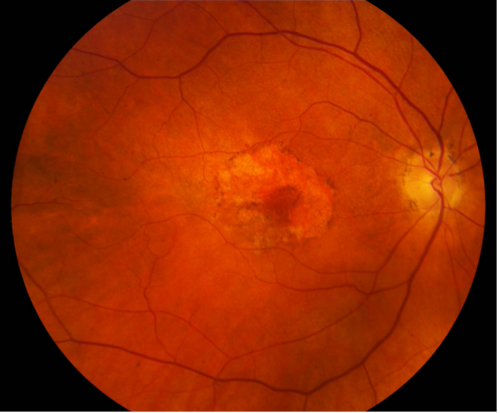This article was originally published in a sponsored newsletter.
It will not come as a surprise to any OD that sight-debilitating diseases are strongly associated with depression. AMD is at the top of this list, especially given that depression is more common in older adults and even more so in older adults with visual impairment.1
In a systematic review of nine studies, Dawson et al showed the prevalence estimates of depressive symptoms in AMD patients which ranged from 15.7% to 44%.2 The lowest estimate from this study is significantly higher than those in the Diagnostic and Statistical Manual of Mental Disorders Fifth Edition (DSM V) for all depressive disorders in the general population.3 Depressive symptoms are more common in people with AMD vs. non-AMD, and there is a higher prevalence of depression with increasing AMD severity.2 Some studies in this review found that neovascular and non-neovascular AMD were both associated with depressive symptoms.2 Depression among AMD patients is most likely to develop in those who experience social and leisure activity limitations.1
Another study by Popescu et al compared rates of depression in older adults with AMD, glaucoma and Fuchs corneal dystrophy and found the highest rate of 39% in the AMD group.4
Further, a cross-sectional study by Inan et al found that exudative AMD (e-AMD) patients scored significantly higher on a standardized depression scale than controls (63.5% vs. 27.5%; P < 0.001).5 The depression scores were positively correlated with duration of e-AMD and patient age (P < 0.05 for all items).5 Using the National Eye Institute Visual Functioning Questionnaire (NEI-VFQ-25; P < 0.001), the e-AMD patients also showed significantly lower mean scores for Quality of Life (QOL) than the controls. These NEI-VFQ-25 scores were significantly lower among patients with bilateral e-AMD than among those with unilateral disease (P < 0.05).5
There is a clear need for support among our AMD patients with depression, but what can we do as ODs to help them? First, we should do brief depression screenings like those done by primary care providers (PCPs). However, we need more education on depression and other mental health conditions that we face as PCPs for the eye.
Rovner et al contributed to this research with The Preventing Depression in AMD trial in which they tested the efficacy of Problem-Solving Treatment (PST) to prevent depression in newly diagnosed AMD patients.6 PST therapists taught patients problem solving skills to compensate for activity limitations during six home-based treatment sessions.6 At two months, 12% of PST participants were depressed compared to 23% of controls (P < 0.05). PST participants were also less likely to relinquish valued activities than control participants (23% vs. 37%, respectively; P = 0.04).6 These results diminished over time, but this study suggests that there are true benefits to us as ODs recommending an adjunct therapy for problem solving in addition to referral for low vision rehabilitation programs. More research in this area would be beneficial.
Lastly, we must provide resources to our AMD patients. The American Macular Degeneration Foundation, MD (Macular Degeneration) Support, Prevent Blindness and The Support Sight Foundation are among my foremost recommendations.


Key Clinical Takeaways
- Prevalence of depression is significantly higher in the AMD population vs. the general population.
- There is a higher prevalence of depression with increasing AMD severity, and neovascular and non-neovascular AMD are both associated with depressive symptoms.
- Depression among AMD patients is most likely to develop in those who experience social and leisure activity limitations.
- Quality of Life (QOL) is significantly diminished for our AMD patients.
- There are true benefits to our AMD patients in recommending an adjunct therapy for problem solving in addition to referral for low vision rehabilitation programs and support resources.
Reference(s):
- Cimarolli VR, Casten RJ, Rovner BW, Heyl V, Sörensen S, Horowitz A. Anxiety and depression in patients with advanced macular degeneration: current perspectives. Clin Ophthalmol. 2016;10:55-63. doi:10.2147/OPTH.S80489
- Dawson SR, Mallen CD, Gouldstone MB, Yarham R, Mansell G. The prevalence of anxiety and depression in people with age-related macular degeneration: a systematic review of observational study data. BMC Ophthalmol. 2014 Jun;14:78. doi:10.1186/1471-2415-14-78
- American Psychiatric Association. (2013). Diagnostic and statistical manual of mental disorders (5th ed.). APA; 2013.
- Popescu ML, Boisjoly H, Schmaltz H, et al. Explaining the relationship between three eye diseases and depressive symptoms in older adults. Invest Ophthalmol Vis Sci. 2012 Apr;53(4):2308-2313. doi:10.1167/iovs.11-9330
- Inan S, Cetinkaya E, Duman R, Dogan I, Inan UÜ. Quality of life among patients with age-related severe macular degeneration assessed using the NEI-VFQ, HADS-A, HADS-D and SF-36 tests. A cross-sectional study. Sao Paulo Med J. 2019 May;137(1):25-32. doi:10.1590/1516-3180.2018.0195071218
- Rovner BW, Casten RJ, Hegel MT, Leiby BE, Tasman WS. Preventing depression in age-related macular degeneration. Arch Gen Psychiatry. 2007 Aug;64(8):886-892. doi:10.1001/archpsyc.64.8.886




